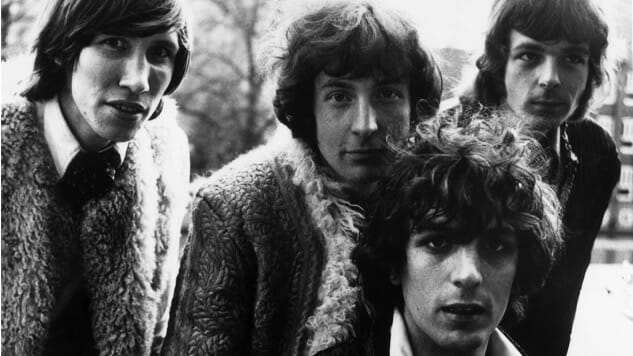The 20 Best Pink Floyd Songs

Eds note: Pink Floyd mastermind Roger Waters is readying his seventh studio album, Is This The Life We Really Want?, for release this Friday. It’s his first straight rock album since 1992’s Amused to Death, a 25-year span that has seen the world gradually inch closer to the one Waters presaged on his classic Pink Floyd albums like Animals and The Wall. So we figured it was a perfect time to look back at the best of the Floyd, in honor of Waters’s return to pedantic, anxious rock music. This summation was originally published on Oct. 20, 2011.
Of all the beloved bands we cover whose song catalogs we’ve tried to rank, that of the iconic progressive-rock group Pink Floyd has been the most difficult. This is largely because the Floyd was an album-oriented band and most of its best work (The Dark Side of the Moon, The Wall, Wish You Were Here) was designed to be absorbed as a single, cohesive unit.
All the same, many of the band’s songs are powerful enough to stand alone through the decades, so we want to celebrate the mind-melting individual highs of this unique, profound and relentlessly adventurous band, which has given us so much strength and inspiration over the years.
20. “When the Tigers Broke Free”
ALBUMS: Pink Floyd The Wall (film soundtrack) / The Final Cut (2004 reissue)
One of the band’s oft-overlooked gems, “When the Tigers Broke Free” could originally only be heard in The Wall film and is bassist and leader Roger Waters’s most direct tribute to his father Eric Fletcher Waters, who died in combat during World War II. An orchestral piece that evokes the solemn atmosphere of WWII, its lyrics skewer the English government for trivializing the lives lost in battle and treating such a serious matter mechanically, which is one reason it fits into the context of The Wall so well: It’s a direct parallel to Waters’s overarching theme of “another brick in the wall.”
19. “Goodbye Blue Sky”
ALBUM: The Wall
A short, acoustic-based piece, “Goodbye Blue Sky” morphs almost impossibly from gentle, beautiful harmonic passages into chilling, harrowing darkness multiple times during its less-than-three-minute run. In the context of The Wall’s story, it’s a lament for the failure of the post-war dream, a promise that involvement in war and conflict would help solve the world’s problems and lead to better society. It also stays consistent with the message of the English government’s disregard for those who suffered because of it. Best seen along with its animated sequence from The Wall film, which juxtaposes elements of Nazism with Christianity amid a horrifying, war-torn landscape.
18. “Set the Controls for the Heart of the Sun”
ALBUMS: A Saucerful of Secrets / Ummagumma
One of the first songs Roger Waters wrote in the wake of Syd Barrett’s mental breakdown and subsequent dismissal from the band in 1968, “Set the Controls for the Heart of the Sun” stays true to Barrett’s psychedelic influence but replaces the fallen genius’s characteristic whimsy with a more formal, somber and haunting tone, one that would become common in Pink Floyd’s later work. Driven by a hypnotic, Eastern-tinged bass line, the studio version pales in comparison to its wildly experimental, extended versions of Floyd’s live shows of the era. The live half of Ummagumma showcases “Set the Controls” at its most riveting and rewarding.
17. “Have a Cigar”
ALBUM: Wish You Were Here
“Have a Cigar” has the distinction of being the only Pink Floyd song whose lead vocal is sung by someone who isn’t a member (save Clare Torry’s performance on “The Great Gig in the Sky,” though her vocal part functions as more of an instrument). The story goes that Roger Waters intended to sing it, but his voice was suffering from severe strain during the sessions, so they got English folk singer Roy Harper to fill in. Harper’s performance dovetails beautifully with the slick, funky track that concerns the dangers of giving up creative and artistic integrity when faced with monumental success—Waters’s direct response to the watershed sales of The Dark Side of the Moon. Topped with a searing guitar solo by David Gilmour, “Have a Cigar” is one of Pink Floyd’s most hard-driving rock tunes and emphasizes the band’s sense of swagger and groove.
-

-

-

-

-

-

-

-

-

-

-

-

-

-

-

-

-

-

-

-

-

-

-

-

-

-

-

-

-

-

-

-

-

-

-

-

-

-

-

-








































